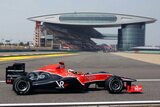
High speeds and high temperatures are virtual certainties for this weekend's Malaysian Grand Prix, as round three of the FIA Formula One World Championship takes place at the Sepang International Circuit. Typical ambient heat of more than 30 °C and high seasonal humidity present an annual challenge to equal the fast, twisty nature of the track: heavy tropical downpours are a near-certainty and the unscheduled arrival of storm clouds is beyond the control of even F1's brightest minds.
Located 85 kilometres from Malaysia's capital, Kuala Lumpur, the SIC was purpose-built over 18 months from 1998-99 to bring Formula One to the country and to create a 'landmark' F1 venue. The design and construction of the circuit on a former 260-hectare oil palm plantation was overseen by German architect Hermann Tilke, who has since gone on to construct a number of state-of-the-art Formula One tracks. From the first edition of the race in 1999, the Malaysian Grand Prix has always provided drama and incident and the 2010 event is not expected to be any different.
CHANGES TO THE CIRCUIT SINCE 2009
Other than routine maintenance no significant changes have been made.
FAST FACTS: MALAYSIAN GRAND PRIX
Alex Yoong remains the only Malaysian to have competed in Formula One. He started 14 grands prix for Minardi over the 2001-02 seasons, achieving a best finish of seventh at the '02 Australian Grand Prix.
Stewart Grand Prix pioneered a novel sponsorship arrangement with the Malaysian government on its entry into Formula One in 1997. Stewart cars carried the government's 'Visit Malaysia' message in place of the more conventional brand sponsorship logos.
The Sepang International Circuit's 'double-straight' layout allows the full grand prix loop to be divided easily into two shorter, 'north' and 'south' circuits. Two races can be run simultaneously, if required.
Built on the site of a former oil palm plantation, SIC's construction required more than nine million cubic metres of earth to be removed before foundations could be laid. 5000 palm trees were planted to replace those lost and improve the circuit's environment. The track measures 22 metres at its widest point.
SIC was the first of Hermann Tilke's Formula One circuit designs. Tilke has since built all-new F1 facilities at Shanghai, Bahrain, Istanbul and Abu Dhabi, as well as modifying F1 circuits in Spain, Japan, Germany and France.
CIRCUIT DATA
Length of lap: 5.543km
Lap record: 1:34.223 (Juan-Pablo Montoya, Williams-BMW, 2004)
Start line/finish line offset: 0.000km
Total number of race laps: 56
Total race distance: 310.408km
Pitlane speed limits: 60km/h during practice sessions;
100km/h during qualifying and race
ADDITIONAL MEDIA OPPORTUNITIES
Qualifying: All drivers eliminated in Q1 or Q2 will be available for media interviews immediately after the end of each session, as well as drivers who participated in Q3, but who are not required for the post-qualifying press conference. Where? At the back of the FIA garage, paddock side.
Race: Any driver retiring before the end of the race will be available for media interviews after his return to the paddock. In addition, all drivers who finish the race outside the top three will be available for media interviews immediately after the end of each race, at each team's individual garage/hospitality.
In addition, during the race every team will make available at least one senior spokesperson for interviews by officially accredited TV crews. A list of those nominated will be made available in the media centre.
Malaysia Sepang International CIRCUIT'S LOCATION
Comments:








